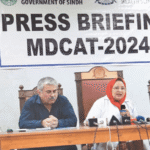Introduction
In recent months, Pakistan’s economy has demonstrated promising signs of recovery, particularly through a notable 14% surge in exports at the beginning of the fiscal year. This growth, bolstered by the initiatives of the Special Investment Facilitation Council (SIFC), has been pivotal in reshaping the country’s trade dynamics. According to the Pakistan Bureau of Statistics, merchandise exports rose to $5.1 billion in August 2024, reflecting a substantial increase of $620 million compared to the same period last year. This positive trend not only contributes to a narrowing trade deficit but also signifies a shift in the economic landscape of Pakistan, underscoring the impact of government strategies aimed at enhancing export performance.
The Trade Deficit: A Focus on Recovery
One of the most significant outcomes of the recent export growth is the corresponding decrease in Pakistan’s trade deficit, which has narrowed by 4.2% to $3.6 billion in the early months of fiscal year 2024-25, down from $3.751 billion. This reduction in the trade deficit is indicative of a more balanced trade scenario, which is critical for economic stability.
Understanding the Trade Deficit
A trade deficit occurs when a country’s imports exceed its exports. This imbalance can lead to several economic challenges, including increased borrowing, depreciation of the national currency, and a negative impact on the country’s foreign exchange reserves. By successfully increasing exports while reducing imports, Pakistan is taking proactive steps to correct this imbalance.
Government Initiatives and Strategies
The government’s strategic initiatives, supported by SIFC, have played a crucial role in this economic turnaround. The SIFC was established to create a favorable environment for investment and trade, aiming to streamline procedures and facilitate both local and foreign investments.
Key Strategies Implemented by the SIFC
- Trade Liberalization: One of the most impactful strategies has been the introduction of a new trade liberalization plan. This plan aims to reduce tariffs on essential goods, streamline customs procedures, and encourage the export of Pakistani products. By making it easier and more cost-effective for businesses to trade, the government hopes to stimulate growth in the export sector.
- Financial Incentives for Exporters: The government has implemented financial incentives for industrialists to boost production and enhance export capabilities. These incentives include tax breaks, subsidies for export-oriented industries, and low-interest loans. Such measures are designed to motivate businesses to increase their output and explore new markets.
- Sector-Specific Support: Identifying key sectors for targeted support has also been an essential component of the government’s strategy. Industries such as textiles, agriculture, and technology have been prioritized, given their significant potential for export growth. By focusing resources and support on these sectors, the government aims to maximize the benefits of its initiatives.
Impact on Key Sectors
Textiles: The Backbone of Exports
Pakistan’s textile industry has long been the backbone of its export sector, accounting for a significant portion of total exports. The recent initiatives under the SIFC have revitalized this crucial sector, enabling it to better compete in international markets.
Innovations in Textiles
Investments in technology and innovation within the textile sector have led to enhanced production processes and improved product quality. By adopting modern manufacturing techniques and sustainable practices, Pakistani textile producers are better positioned to meet the demands of global consumers. This shift not only boosts exports but also enhances the industry’s reputation on the world stage.
Agriculture: Harnessing Potential
Agriculture is another key sector that has benefited from the government’s strategic support. With a focus on increasing productivity and improving supply chains, the agricultural sector has seen growth in exports of products such as rice, fruits, and vegetables.
Quality Control and Certification
Efforts to improve quality control and obtain international certifications have allowed Pakistani agricultural products to gain access to new markets. These initiatives ensure that products meet global standards, thereby increasing their competitiveness and appeal to foreign buyers.
Technology and IT Exports
The technology sector in Pakistan is rapidly evolving, with a growing number of startups and established companies making significant contributions to the export landscape. The government’s emphasis on fostering innovation and providing support for tech companies has resulted in a surge in IT exports.
Global Market Expansion
Pakistani IT companies are increasingly tapping into international markets, offering software development, IT services, and digital solutions. By promoting the “Make in Pakistan” campaign, the government encourages the tech industry to expand its reach and enhance its export capabilities.
Decline in Imports: A Strategic Shift
In conjunction with the growth in exports, there has been a noticeable decline in imports of high-duty items, such as vehicles, household appliances, and essential goods like garments and fabrics. This decline is indicative of a strategic shift in the country’s consumption patterns and economic policies.
Rethinking Import Dependency
The government’s approach to reduce reliance on imports is aimed at promoting local production. By encouraging industries to manufacture goods domestically, Pakistan can create jobs, stimulate economic growth, and strengthen its trade balance.
Implications of Import Reduction
- Boosting Local Industries: The decline in imports opens up opportunities for local industries to fill the gap. By investing in domestic production, Pakistan can create jobs and reduce unemployment.
- Improving Trade Balance: Reducing imports while simultaneously increasing exports contributes to a healthier trade balance, which is crucial for long-term economic stability.
- Strengthening Currency: A reduced trade deficit can lead to an appreciation of the national currency, improving purchasing power and stabilizing the economy.
The Government’s Economic Stabilization Measures
In addition to the initiatives aimed at boosting exports, the government has undertaken various measures to stabilize the economy. These measures are vital for ensuring sustained growth and resilience in the face of external challenges.
Debt Management and Reduction
Recent months have seen a concerted effort to manage and reduce Pakistan’s external debt. This strategy is essential for improving the country’s creditworthiness and attracting foreign investment.
Effective Debt Management
The government’s approach includes renegotiating debt terms, seeking favorable loans, and implementing fiscal policies that prioritize debt reduction. By taking these steps, Pakistan aims to alleviate the burden of external debt, paving the way for more sustainable economic growth.
Monetary Policy Adjustments
The State Bank of Pakistan has adjusted its monetary policy to align with the government’s economic goals. These adjustments are designed to control inflation while supporting economic growth.
Interest Rate Management
By carefully managing interest rates, the central bank aims to create an environment conducive to investment and consumption. Lower interest rates can encourage borrowing and spending, stimulating economic activity.
Infrastructure Development
Investing in infrastructure is critical for supporting economic growth and enhancing export capabilities. The government is focusing on improving transportation networks, energy supply, and logistics systems to facilitate trade.
Enhancing Connectivity
Better infrastructure enhances connectivity between production centers and markets, reducing transportation costs and improving the efficiency of supply chains. This investment is vital for ensuring that Pakistani goods can compete effectively in international markets.
Future Prospects: Sustaining Growth
While the recent surge in exports and narrowing trade deficit are encouraging signs, sustaining this momentum will require ongoing efforts and strategic planning. Several key areas must be prioritized to ensure continued growth:
Long-term Investment in Innovation
To maintain competitiveness, Pakistan must invest in innovation across all sectors. This includes supporting research and development initiatives, promoting technology adoption, and fostering a culture of entrepreneurship.
Education and Skill Development
Investing in education and skill development is essential for equipping the workforce with the necessary skills to thrive in a rapidly changing global economy. A focus on STEM (science, technology, engineering, and mathematics) education can help create a skilled workforce capable of driving innovation.
Expanding Market Access
Exploring new trade agreements and partnerships can provide Pakistani products with access to larger markets. The government should prioritize negotiations with potential trading partners to enhance export opportunities.
Strengthening Regulatory Frameworks
A robust regulatory framework is crucial for creating a stable business environment. The government should focus on simplifying regulations, reducing bureaucratic hurdles, and enhancing transparency to attract both local and foreign investment.
Conclusion
Pakistan’s recent export surge, supported by the SIFC and various government initiatives, marks a significant turning point in the country’s economic landscape. The reduction in the trade deficit, coupled with the decline in imports, demonstrates a proactive approach to achieving economic stability. By prioritizing innovation, infrastructure development, and strategic partnerships, Pakistan can build on this momentum and foster a more robust and sustainable economy.
The road ahead will require concerted efforts from both the government and the private sector. By working together to implement effective strategies and policies, Pakistan can secure its position in the global market and create a prosperous future for its citizens. As the country navigates the challenges and opportunities of a dynamic economic environment, the focus on exports and local production will be essential for long-term success.
#PakistanEconomy #ExportGrowth #SIFC #TradeDeficit #EconomicStability #InvestmentStrategies #LocalProduction #Innovation #InfrastructureDevelopment #FutureProspects







